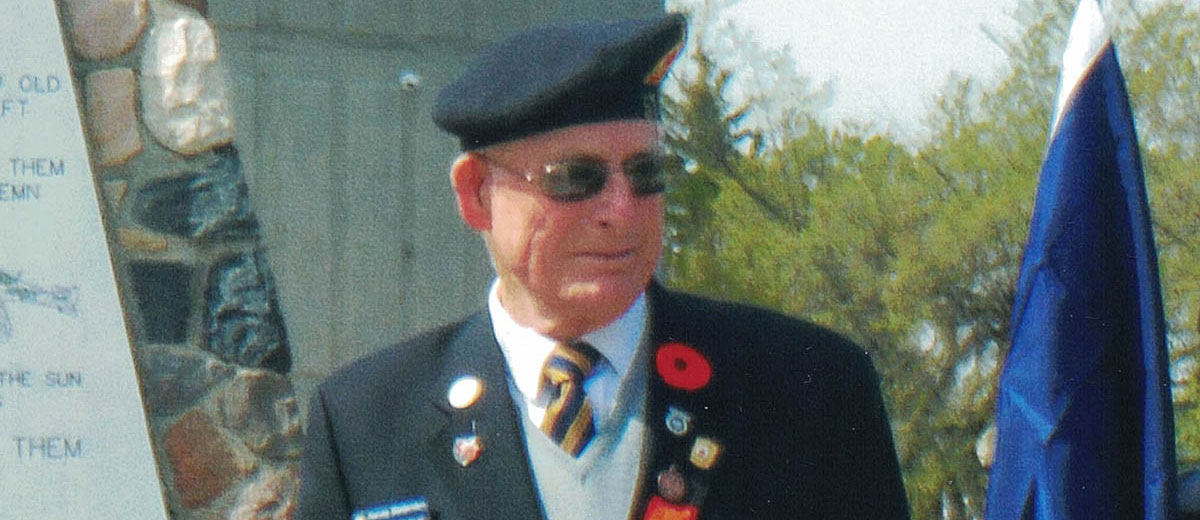When the Battle Cry is spoken,
And the Voice of War is heard,
The soldiers of the Allies,
To battlefields do move.
The enemy is silent,
As if waiting for the sun,
Then they hear that awesome sound,
The booming of the Guns…
The shells come whistling all around
And wreck and break and knock things down,
Creating havoc among the lines
And all that it surrounds…
The Allies are victorious,
The enemy is on the run,
Once again they have been beaten
By the Glory of the Guns.
– (Excerpted from “Glory of the Guns” by Gunner MR Duncan)
For Harvey Balderston, the above poem is more than just poetry—it brings back memories of over four years of service in World War II.
Balderston, born and raised in Kindersley, traveled to Rosetown, SK to sign up for the Canadian Army in July of 1941 when he was only 18. “21 other boys from Kindersley signed up the same time I did,” Balderston recalled. Army life started right away for the recruits: it was parades in the day and 6-8 men in a tent at night. Balderston remembered one terrific summer storm blowing into Rosetown, dumping hail, blowing tents over and sending Balderston and buddies scrambling to the nearest hotel.
In August, Balderston left Saskatchewan for Petawawa, ON, for more military training before heading across the Atlantic. The trip across the frigid Atlantic Ocean in November took longer than a tradition five day journey as the fear of submarines sent the ship far north before docking at Scotland. Balderston laughingly recalled the British trains, and how small they seemed compared to the robust trains in North America. “They were like little ‘beep’ ‘beep’ trains, but they sure could move! They hustled us all the way from Scotland to Colchester, England.”
Once in Colchester, the oldest town in England, Balderston’s training began in earnest. Joining the 67 Battery 7th Regiment, Balderston became an anti-aircraft gunner and moved from post to post in southern England, protecting her from the dwindling German bomb-raids.
In 1943, Balderston transferred to another regiment and became a gunner for a BL 5.5 Medium Gun, a British Artillery gun with shells weighing up to 100lbs. “They called us the 9-mile snipers, we were that accurate, though we never actually saw what we were shooting at. We would get the word to fire about a certain amount of rounds into a particular location, given in degrees, so we did.”
The medium gun crew was normally around 10 men and Balderston’s crew grew so well practised that they easily fired 2 rounds per minute. Working with the Medium Gun was not easy, and it certainly wasn’t quiet. “First the British tried to give us rubber ear plugs, but they didn’t work too good, so we used cotton batting, and used helmets to protect our heads. Balderston remembers scrambling to load the gun, hearing the hoarse “fire!” and ducking to the ground to protect his head and face from flying debris, only to jump back up again to ready for the next round.
Once, during a critical point in an Allied invasion attack, Balderston’s crew was told to fire continuously until they received other orders. The crew leapt into action and fired rounds every 15 seconds, a whopping 5 rounds per minute until the Allies troops broke the German lines. “Technically, we were being rather unsafe as the gun barrels get real hot when they are being fired like that; but we knew those boys needed help, so we gave it to them.”
Balderstone’s crew hit the lines just past Juno Beach about one month after the D-Day, the Allied Invasion in June 1944. “Once we hit Europe, we were busy, at any time during the day or night; we would fire away at whatever the commanders wanted us to shoot at.”
Travelling up the French coast into Belgium, The Netherlands and eventually into Germany itself was busy and dangerous work as his crew never knew if they would come under fire from the Germans or even from their own side. Balderston remembered traveling one night in a convoy stretching for miles; a plane flew low, scanning the road. They couldn’t see who it was; suddenly a flare dropped out of the sky and lit up the convoy with a blinding flash. “In that moment you realized that there was nowhere to hide, you felt as though the whole world was looking at you and you were as small as a field mouse.” The plane, for unknown reasons, did not open fire but quickly reminded all present that they were never safe.
Not everything in Europe was fast moving or exciting — the food was one good example. “Anyone who remembers the war will definitely remember the meat and vegetable stew. It was porridge for breakfast, meat and vegetable stew for lunch, and then vegetable and meat stew for supper. I suppose it was nourishing, but it was rather monotonous.”
Balderston served in Europe until VE day, coming home to Kindersley nearly five years after he left it. “Those were the best years of my life, actually. I was with good boys and I learned so much I wouldn’t have learned staying in SK.”
Coming up to Remembrance Day, Balderston has these words for today. “We must remember the sacrifices of so many young men and women; they gave up the best years of their life, some their whole life, so we could live in peace today — don’t waste it.”
Feature Image: Photo submitted by Harvey Balderston
For the latest information and for more updates on everything Kindersley, ‘Like’ our Facebook page below…
